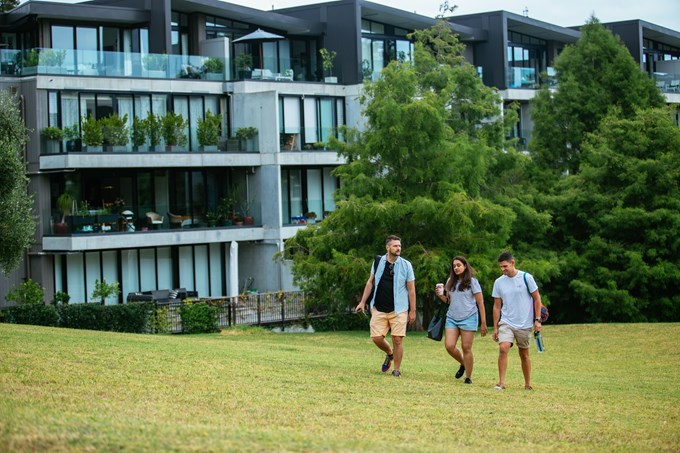We’re shining a light on the stronger role central government has taken in planning for how Auckland must grow by introducing new rules for greater housing density across our city.
Most of the government’s new rules are mandatory, but Auckland Council does have limited scope to make some decisions. Here’s an overview of the big changes and what it means for Auckland.
Auckland’s city centre
Central government requires the council to enable as much building height and density in the city centre as possible for both new homes and businesses.
The city centre is one of Auckland’s fastest-growing residential and employment hubs and is expected to continue growing over the next 30 years. Auckland Council already allows for significant high-rise development within our city centre under the Auckland Unitary Plan.
However, we do limit building heights in a number of areas, for example, on the waterfront, around public spaces like Albert Park and Aotea Square, and for views to our Maunga and other landmarks, and we’re proposing that such areas remain exempt from further building height.
Metropolitan centres
Within Auckland’s metropolitan centres, we must enable building heights of six storeys or more.
Auckland has 10 metropolitan centres, they are Newmarket, Manukau, New Lynn, Sylvia Park, Botany, Papakura, Takapuna, Henderson, Albany, and Westgate.
They are familiar to many Aucklanders as very large places for shopping and entertainment but also employment, education, community services, and apartment living with high-frequency transport.
In the years ahead, these areas are expected to grow significantly as important residential and employment hubs.
Most of our metropolitan centres already allow buildings higher that six storeys and where building heights are currently lower than six storeys, we’re proposing that these limits continue.
Walkable catchments
Around our city centre, 10 metropolitan centres and rapid transport stops, the government requires us to have ‘walkable catchments’ where building heights of six storeys or more must be enabled.
These are areas around urban centres or public transport stops where people can live within walking and cycling distances to work, shops, services, schools or to catch a bus or train to get around.
We’re proposing a 15-minute walking distance to the city centre (around 1200 metres) and a 10-minute walking distance (around 800 metres) to our metropolitan centres and around Auckland’s train and Busway stations.
Within these walkable distances, it will mean big changes to the rules for how property owners can choose to develop their property, if they wish.
However, it also means options for more housing close to large centres and public transport, where it makes better use of the space we have. And it puts more people in easier reach of the places and services they use every day, without relying on a car.
Having more walking, cycling and public transport options helps to reduce harmful greenhouse gas emissions, urban sprawl and congestion with people using cars less or driving shorter distances.
Around other suburban centres
Within and around Auckland’s other suburban centres - think of these as local high streets with shops and services - height and density limits are required to match the level of business and community services available within each centre.
The Auckland Unitary Plan already enables more height and density within and around most of these centres than in general suburban residential areas.
However, to meet this central government requirement, we’re proposing a more consistent approach, with increases in the height and density limits around a number of Auckland’s larger local and town centres that have good access to public transport, places such as Mangere East, Meadowbank, Milford and Hunters Corner.
This would see townhouses, apartments, and terrace housing in some new places or expanding on where it currently exists around these centres, as many of these areas already allow for growth.
More three-storey homes across the city
With new Medium Density Residential Standards introduced in December 2021, the government also requires the council to enable more housing of up to three storeys on most residential sites across the city.
This will enable more homes, like town houses, terrace housing and low-rise apartments, across almost all Auckland suburbs. The legislation also requires changes to the council’s design rules for how sites can be developed, as these have now been set by the government.
Exemptions to reduce mandated building height and density
The government allows some exemptions for mandated three and six storey building heights. Called ‘qualifying matters’ they can be used to limit building height and density requirements within some areas where they may not be suitable, such as protecting areas of cultural or historic significance, or avoiding places at risk from natural hazards.
To use a qualifying matter, we must provide strong evidence to prove why an exemption is needed. It does not prevent development in an area, instead these exemptions only limit development enough to make sure what is being protected or managed isn’t compromised by further intensification.
It means we cannot simply ‘roll over’ existing protections for an area, but the council can use qualifying matters for things that are important to our city.
Be heard on Auckland’s housing future
On 18 August 2022, Auckland Council publicly notified its proposed changes to the Auckland Unitary Plan that respond to the National Policy Statement on Urban Development – called Plan Change 78. This means people can make a submission on the proposed changes.
See more information about Plan Change 78 and make a submission online through the Auckland Council website
Submissions are open from 18 August until 29 September 2022.
A submission is how you can get involved by giving your views on the proposed changes to our city’s planning rules to be considered by an Independent Hearings Panel.
This Panel will consider all submissions, hear directly from people who submitted, and make recommendations to the council on changes to the Auckland Unitary Plan in early 2024. The council is required to make its final decisions by 31 March 2024.


